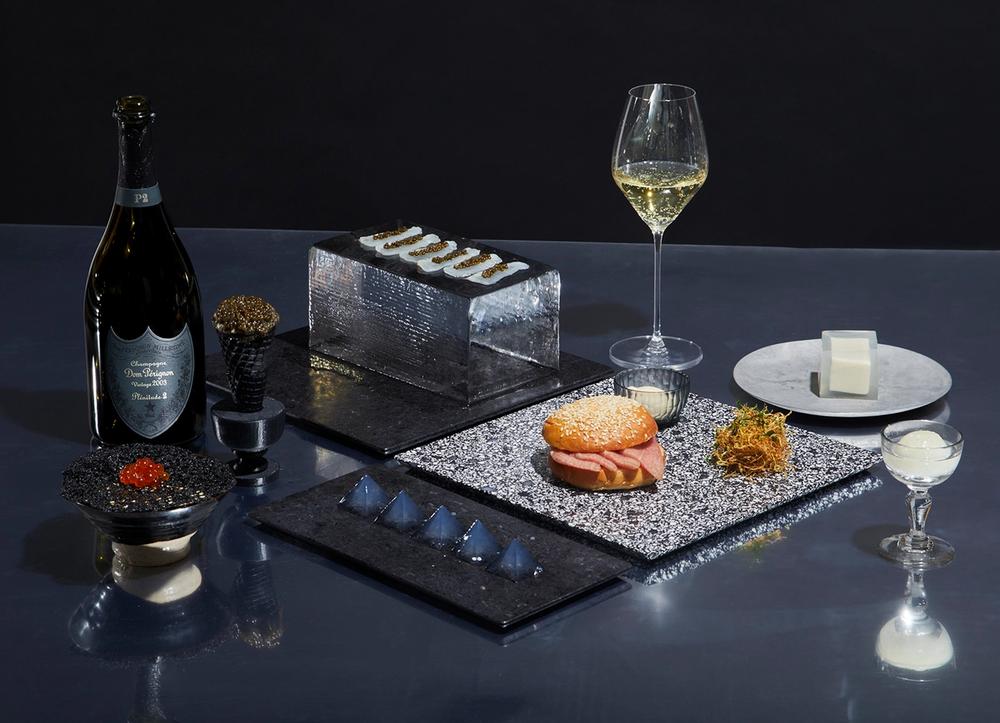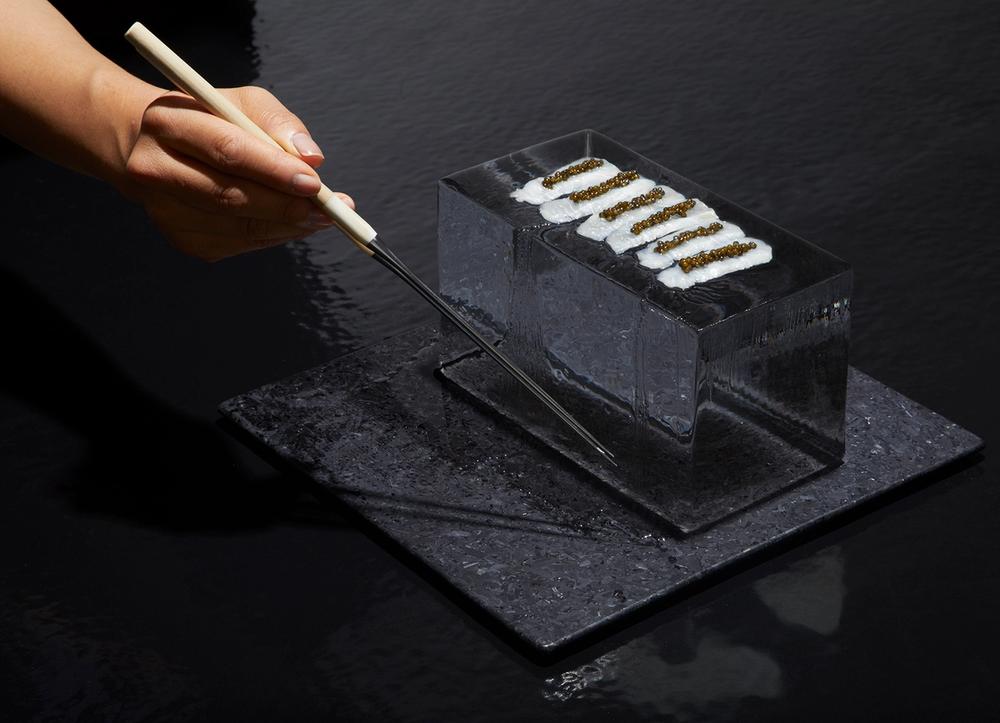Pairing Champagne and Ice Cream, Stephanie Goto Masterminds an Extraordinary Omakase
Stephanie Goto thinks about champagne and ice cream in similar ways to how she does design: spatially, materially, and as an intricate array of layers and forms. With her friend Nicholas Morgenstern, the chef and owner of Morgenstern’s Finest Ice Cream, the New York–based architect recently merged these seemingly disparate interests into a wholly original, decidedly unusual, extraordinarily sensorial limited-run omakase. Starting July 20 and running through August 10, the seven-course pairing menu—celebrating the release of Dom Pérignon’s Plénitude 2 Vintage 2003—will be available on Tuesdays, with seatings at 6 p.m. and 8:30 p.m., by reservation only at Morgenstern’s Sundae Bar, part of its flagship location in New York’s Greenwich Village. (Those wanting to try a single pairing can make a reservation to do so between noon and 10 p.m.)
A Dom Pérignon collector and long-time friend of the brand, Goto worked closely with the company’s chef de cave, Vincent Chaperon, throughout the process of creating the menu, learning the details and nuances that go into constructing a Dom Pérignon vintage—“the structure of the wine, and the deeper definitions of why it is what it is,” as she puts it. With Morgenstern, Goto selected some of their favorite Japanese ingredients, such as tamago, soy sauce, and dashi, and then she designed an edible experience that playfully reimagines and transforms these ingredients into a theatrical story about ice cream and champagne, presented in three acts.
Among the over-the-top offerings (featuring plates designed by Goto, as well as various tableware items from her personal collection) are a nori cone with sushi rice ice cream and Black River Caviar’s imperial-grade Russian Oscietra Caviar, paired with a glass of the Vintage 2010; a toro burger with a side of soy sauce ice cream and ginger “fries,” paired with a glass of the Rosé Vintage 2006; and a sundae cube made from matcha, red bean, vanilla, and dorayaki, paired with the Plénitude 2 Vintage 2003. Here, we speak with Goto about how the exquisitely executed project came to be.
When and how did your relationship with Dom Pérignon begin?
When I landed in New York after graduating [from Cornell], through my love of music and Carnegie Hall I met a brand ambassador of Dom Pérignon one evening during a concert. From that moment on, there was an immediate connection and access that allowed me to dive deep [into the brand]. Along the way, I met Richard [Geoffroy, the company’s chef de cave from 1990 to 2018], and he further opened the doors to this unbelievable world. There were so many synergies between the wine and what I do that at some point it made sense that we would collide like this.
How did you first connect with Nicholas Morgenstern?
Nicholas and I met at Montrachet—this classic, quintessential, nineties New York restaurant in Tribeca. I’d been tapped by [restaurateur] Drew Nieporent to transform it into [the now-shuttered New French restaurant] Corton. Its chef and co-owner, Paul Liebrandt, asked Nicholas to be the pastry chef, so throughout the process of conceptualizing the restaurant, we had several meetings. We shared a curiosity for detailed perfection, a sense of being really passionate about what we do.
Nicholas didn’t end up working there, but our friendship continued. I would always come up with crazy ideas to do with him, like making chocolates in these geometric, architectural shapes. Our friendship has been a back and forth of creativity.
You’ve been working on several ice cream flavors with him, right?
Yes. We’ve started—and this is really just the beginning—creating a series of flavors that are reflective of my [Japanese American] heritage and nostalgia for my childhood. One of the creations is She’s So Goto, a shiso ice cream. In the project with Dom Pérignon, we’ve expanded on our ideas.
Ice cream is about nostalgia in some ways. Being able to harness my heritage, this idea of “Japan-ness”—where it’s not Japanese, but there’s an undeniable Japanese quality, an essence—has been really important.
How did you conceptualize this omakase?
Nicholas had always been thinking about ice cream beyond ice cream. We sat down in my studio and started sketching ideas. We were bouncing back and forth between East and West, high and low, Japan and the U.S. and France, trying to think about how to express that [concept] in ways that people hadn’t seen before.
Dom Pérignon is so much about what underlies it—what happens to the grapes because of the climate makes its wine really special. We wanted our menu to talk about some of the things that are a part of that process—the light, the energy of the sun—as well as the darkness of the cellar, the lightness when the champagne is poured out of the bottle, and the starlike quality of the wine. We wanted to question the notion of: Where is the sensory stimulation coming from? When you’re holding an all-black ice cream cone that looks like a dessert but tastes like the sea, what does that mean?
Any favorite flavors or dishes from the project?
The clear standout and the most profound—and this goes back to how we wanted the dishes to reflect the wine—is the “Verticality” dish, presented in a black ceramic bowl. Veiled in squid-ink tuile and topped with salmon roe, it’s followed by tamago ice cream and a uzu dashi gelee with sea urchin inside. This, to me, reflects the three-dimensional quality of the wine. Whether or not people see it that way is the viewers’ choice, but we wanted the opportunity for people to take from that and discover the flavors. It’s the most architectural of all the experiences.
What are your hopes for the project?
What’s important to know is that while there’s the glamorous side of Dom Pérignon, there’s also a serious wine-making side that’s way more exciting. What they do to make the wine is incredible. Maybe it’s my mission to tell that story: How can I teach people about the darkness, the lightness, the perspective—all these spatial qualities—and about how time impacts the wine and the maturation?
This is just the beginning of thinking beyond boundaries, beyond culture. Nicholas has always been saying to me, “I want you to continue to push me to do the unexpected with ice cream.” My hope is that this is just cracking the door open to that challenge. And to Dom Pérignon’s credit, that idea of building vintages really aligns with how we were approaching this project. There’s a harmonious dialogue, rather than leaving it at the surface with just ice cream and a glass of champagne. It’s beyond that.




